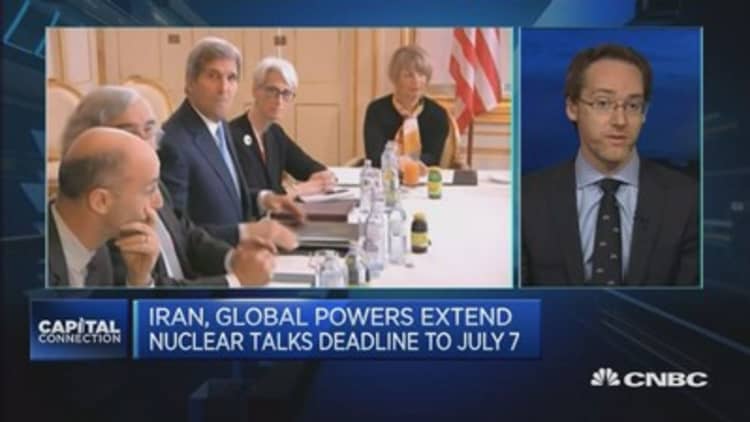'Don't panic about oil' is the message from experts, even as traders factor in big price slumps this year amid expectations for a return of Iranian crude exports.
The lifting of sanctions against Tehran in July could unleash a flood of Iranian oil into global markets in the coming months, according to commentators like JP Morgan and The Schork Report. That could further depress Brent prices, which are already 44 percent lower over the past year.
Read MoreWhy an Iran deal could mean lower oil prices
But that scenario is unlikely to pan out, warns Azlin Ahmad, crude oil editor at Argus Media. She believes meaningful volumes of Iranian crude will only hit markets in mid to late 2016, assuming a nuclear deal is reached.
"After years of under investment and aging fields, Iran's spare production capacity could be as little as around 200,000 barrels a day, although that could increase to 500,000 by the end of 2016. It's going to take some time for Iran to ramp up its production."
Even if a nuclear agreement is signed within a few weeks, it could be months before sanctions are actually lifted, she added.
Tehran is negotiating an accord with six major powers known as the P5+1 —Britain, China, France, Germany, Russia and the United States— to slash its nuclear capacity in return for sanctions relief. A deal was expected by June 30, but the deadline has now been extended to July 7.
Despite the delay, analysts are confident an agreement is in sight. Iran, home to the world's fourth largest oil reserves, will then be allowed to boost its crude exports to international markets. In March, Iranian oil minister Bijan Zanganeh said the country could add a million barrels to daily oil output "within a few months" of sanctions lifting.

But Marina Petroleka, head of energy and infrastructure at BMI Research, calls one million additional barrels an unrealistic goal.
"There's a lot of talk from Iran they could do a lot in a short time but we don't think they have the capacity to do so...We do expect a deal, but oil sanctions will actually be the last thing that's lifted so we're looking at 2016 for first Iranian volumes to hit markets ," she said.
"One million barrels is very optimistic. That needs a lot of capital injections to get the mothballed oil fields working again. We factor in 500,000 to 600,000 starting after January and rising throughout the year" she added.
Iran has a lot of easily accessible onshore oil but years of neglect and aging means the country needs new technologies and international oil companies (IOCs) to really ramp it up, she explained.
It's unclear how much foreign capital Tehran needs to repair its oilfields, but Argus Media's Ahmad says it all boils down to what kind of contract terms they can offer IOCs.
"Iran will have to prioritize enhanced oil recovery in its mature fields, and it's offering hybrid service contracts with flexible rewards. We're seeing European companies are keen to get into Iran and lining up, but even for upstream companies they need a clear indication on where the sanctions will be lifted and competitive terms."
For now, the Persian Gulf nation seems to be courting more European companies than Russian or Chinese firms who are already active in neighboring Iraq, she added.


